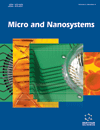- Home
- A-Z Publications
- Micro and Nanosystems
- Previous Issues
- Volume 16, Issue 3, 2024
Micro and Nanosystems - Volume 16, Issue 3, 2024
Volume 16, Issue 3, 2024
-
-
Pharmaceutical Applications and Advances with Zetasizer: An Essential Analytical Tool for Size and Zeta Potential Analysis
More LessAuthors: Sonakshi Garg, Preeti Patel, Ghanshyam D. Gupta and Balak Das KurmiZetasizer is an advanced device that measures various properties of particles or molecules suspended in a liquid medium. It is extensively used for evaluating the size of nanoparticles, colloids, and biomolecular particles, and for determining particle charge. There are several analytical techniques by which the size, zeta potential, and molecular weight can be determined, like Dynamic Light Scattering (DLS) that measure Read More
-
-
-
Drug Delivery and Monitoring through Wearable Devices with Microneedles in the Field of the Health Care System
More LessAuthors: K.C. Kumarswamy, B.K. Madhu, N. R. Naveen, Prakash S. Goudanavar and K.N. PurushothamMicroneedles represent a revolutionary advancement in drug delivery and diagnostics, offering a minimally invasive approach to accessing the intricate biological environment of the human body. These micron-sized needles, typically ranging from 25 to 1000 micrometers in length, penetrate the outermost layer of the skin, creating microchannels that facilitate the transdermal administration of therapeutics or the e Read More
-
-
-
Design and Performance Analysis of Strip Photonic Waveguide with Coating Layer for Multimode Propagation
More LessBy Veer ChandraIntroduction: Photonic devices play a pivotal role in the realm of high-speed data communication due to their inherent capability to expedite the transfer of information. Historically, research efforts in this domain have predominantly concentrated on investigating the fundamental mode propagation within photonic waveguides. Methods: This study diverges from the conventional approach by delving into the untapped pot Read More
-
-
-
Towards Simpler Modelling Expressions for the Mechanical Characterization of Soft Materials
More LessAims: The aim of this paper is to develop a new, simple equation for deep spherical indentations. Background: The Hertzian theory is the most widely applied mathematical tool when testing soft materials because it provides an elementary equation that can be used to fit force-indentation data and determine the mechanical properties of the sample (i.e., its Young's modulus). However, the Hertz equation is only valid for par Read More
-
-
-
Nafion/ZrO2 Modified NiTi Orthodontic Wire: Preparation, Material Characterization, and Corrosion Studies
More LessBackground: Nickel-titanium (NiTi) orthodontic wires are widely used in dental corrective procedures due to their high mechanical properties and cost-effectiveness. However, they are prone to oral corrosion, leading to mechanical deterioration, aesthetic issues, and potential health concerns. Objective: This study aims to improve the corrosion resistance and durability of NiTi orthodontic wires by employing zirconium dioxide (Z Read More
-
Most Read This Month
Article
content/journals/mns
Journal
10
5
false
en


